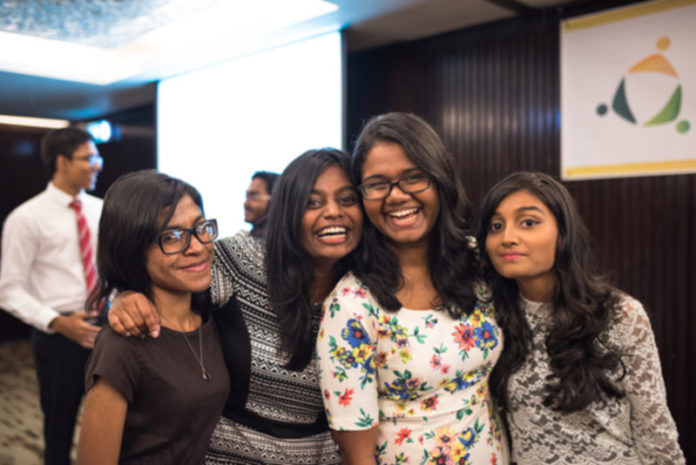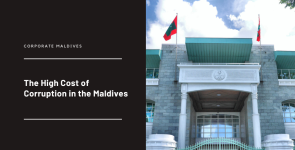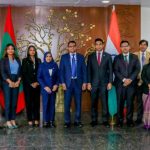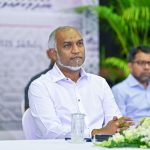
By Alain Sibenaler – UNFPA’s Country Director for the Maldives.
The Maldives is poised to enter a new and exciting chapter in its history — one of even more rapid social and economic development than the impressive growth the country has already achieved. We stand at the doorstep of this new era thanks to emerging population trends. These trends are the results of investments and efforts the Maldives has made over recent decades toward population and development issues, with UNFPA’s support, through family planning, reproductive health, gender equality, and census activities.
However demography is not destiny. The question now is: How the Maldives can harness these emerging trends to ensure a prosperous, sustainable future for all?
UNFPA, in partnership with the National Bureau of Statistics (NBS), recently convened a series of dialogues with youth, policy experts, and academics to answer this question. Three themes emerged from these discussions.
Plan for inclusive growth
First, the Maldives will need to address how best to harness urban and regional planning in a way that takes advantage of migration trends, as well as generates inclusive economic growth.
To this end, it helps to know where people are, and in what numbers. The 2014 Census offers helpful insights to this question. Just one-third of 1 percent of the Maldives is emerged land, resulting in a population that is both dispersed and concentrated. Islands with fewer than 5,000 residents accounted for 183 of Maldives’ 188 inhabited islands, as of the 2014 Census, while a 38 percent of the population lives in Malé, which is one of the most densely populated city in the world.
In addition to plans that will bring an additional 100,000 people or more to Malé, there are also notions of concentrating growth around regional centers with both “pull factors,” such as employment, as well as “push factors.”
To achieve the Maldives’ full potential, it may be necessary to elaborate these plans with policies that take into account population needs holistically. Beyond job creation and focused tourism development, what skills and investments are needed to generate sustainable, inclusive and equitable social and economic growth throughout the country?
While the answers to this question are not yet clear, there is a clear need to start a conversation towards such solutions that takes into account demographic evidence: Maldivians are highly mobile — 53 percent of the total population has migrated at some point in their lives — and often move as families, both for reasons of employment, as well as considerations such as access to health care, housing, and education.
Invest in youth and women
A second, related theme to emerge in our discussions was the mix of social policy and investments that will be necessary to ensure the Maldives’ working-age population achieves its full potential.
According to the 2014 Housing and Population Census, for every two people of working age in Maldives (15 to 64 years old), there is just one dependent — those under 15 years old (27 percent of the population) or over 65 years old (5 percent).
This large working-age population is the result of investments the Maldives has already made in lowering fertility rates and improving health outcomes overall; more people are having fewer children and living longer.
However, universal access to reproductive health remains an unfinished agenda in Maldives, particularly for youth and unmarried people, who often face barriers to accessing family planning. UNFPA remains concerned about reproductive health outcomes among youth in Maldives. Ensuring universal access not only fulfills a fundamental right, but also helps ensure the progress that Maldives has so far achieved are not reversed, which could jeopardize the country’s limited window of opportunity to launch the phase of growth known as the “demographic dividend.”
Never before has the Maldives enjoyed such a large youth population. Almost half (47 percent) of the country’s population is less than 25 years old. This is both a challenge and an opportunity. UNFPA has been discussing evidence that suggests a mismatch between jobs and skills with leaders in the country, who lament that the education system does not produce people ready to be employed.
While some of the gaps between the labour market and the workforce’s skills can be anticipated and bridged with targeted vocational training, demographic evidence suggests some very significant gains can be achieved through investments towards gender equality — particularly women’s agency in decisions affecting them, such as employment, health, and rights.
During our discussions, one educational administrator spoke of how his university’s efforts to bridge one skill shortage in particular, the need for nurses, were persistently thwarted: The Maldives National University graduates more than 100 female nurses every year, and yet so few new graduates actually enter the workforce.
Young women have surpassed their male peers, in terms of higher educational attainment and enjoy lower rates of unemployment than young men. However, these slight advantages do not translate into better — or even equal — employment outcomes later in life. Beginning Maldivian women’s early 20s, around the average age of first birth, women suffer higher unemployment rates, and this continues throughout their reproductive years. As a result, too few women rank among organizations’ higher echelons in decision-making roles. Why are so many more working-age women than men out of the workforce entirely? How do we support them and tap into their full potential? Further research is needed to address these questions.
Throughout our discussions, there is a sense that the Maldives has “missed the boat” on gender issues. Youth perhaps offer the most exciting opportunity for improving gender equality through a generational transformation built on inclusive dialogue about evidence that goes beyond statistics.
Prepare for change
The third theme that emerges from our discussions is the question of how Maldives will prepare for the future’s knowns and unknowns. There is a considerable deal of concern about ageing. Fortunately, an analysis of 2014 Census data conducted by UNFPA and NBS suggests that Maldives has considerable time to answer the question of how the country and communities will care for the population as people begin to live longer and grow older in larger numbers.
If the Maldives manages to seize the potential benefits of a first demographic divided through the right mix of mix of investments in youth, evidence suggests this may be the be the country’s best chance at a second demographic dividend — one in which today’s youth invest, save, and ensure economic security both for next generation, as well as those growing older in future decades.
While the Maldives can be proud of achieving gender parity in many important measures of life, do women enjoy equal life expectancy? Do both young and older women enjoy equal economic security as men, particularly amid high divorce rates and after lifetimes spent more often in informal or family-based employment, which offers significantly less job security and opportunity for savings? These are important questions for future research.
Ensuring today’s youth age healthily is an important problem. While reproductive health remains UNFPAs primary concern, the social and economic consequences of con-communicable diseases (NCDs), often stemming from lifestyles associated with urbanization and affluence, also should not be discounted. Populations’ resilience to shocks resulting from climate change also offers important directions for future research
However, all of the research in the world is useless, if it is not used. This is why UNFPA is working to ensure data that the Maldives collects is both understood by the public and conveyed to decision makers.
With Maldives now an upper middle-income country, UNFPA’s role has shifted towards ensuring that evidence informs the choices that the country’s leadership makes. Whatever model for population and development the Maldives adopts or creates for itself, UNFPA stands ready to catalyze links and synergies among existing policies so that every person in the Maldives achieves their full potential.












